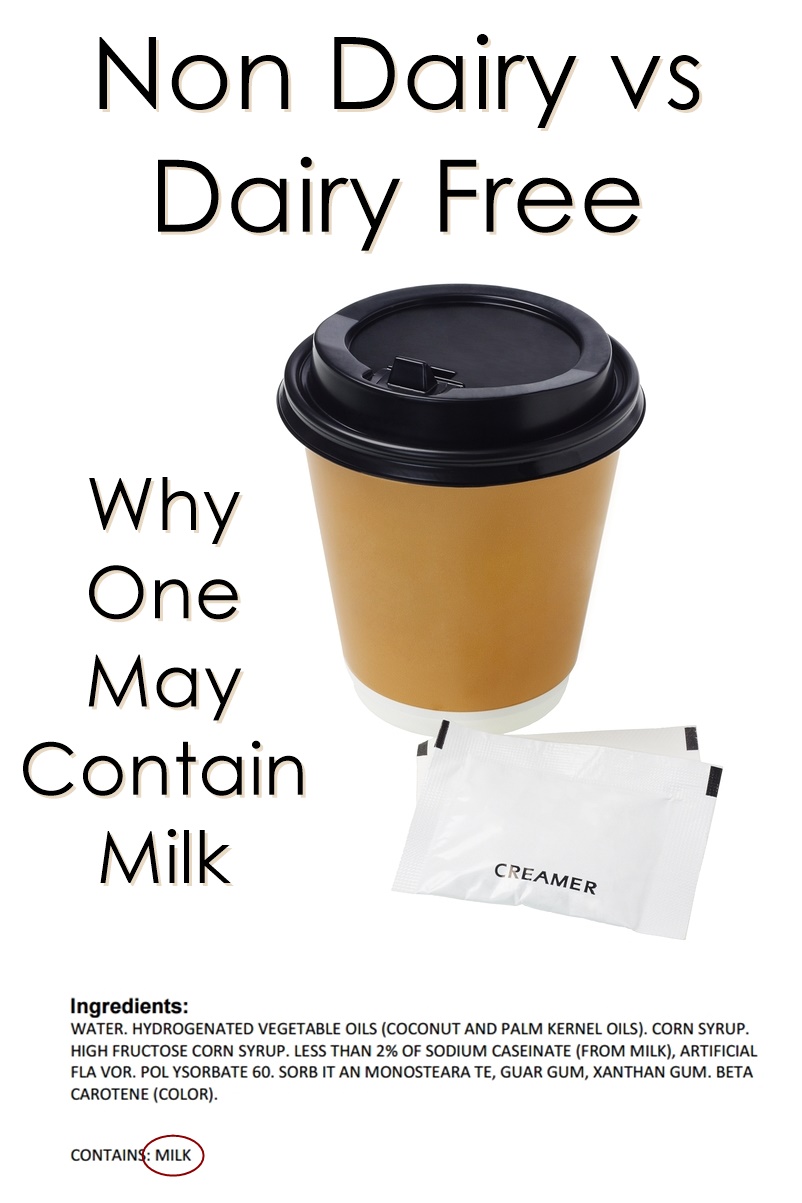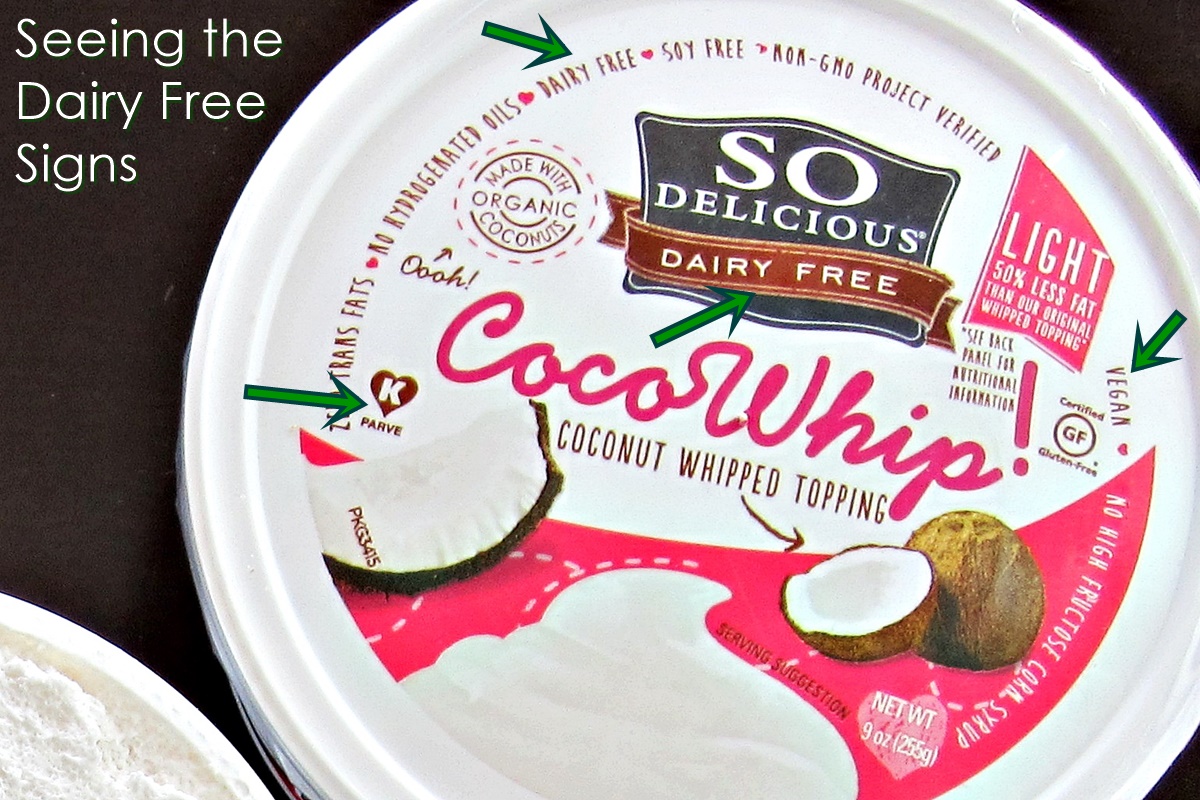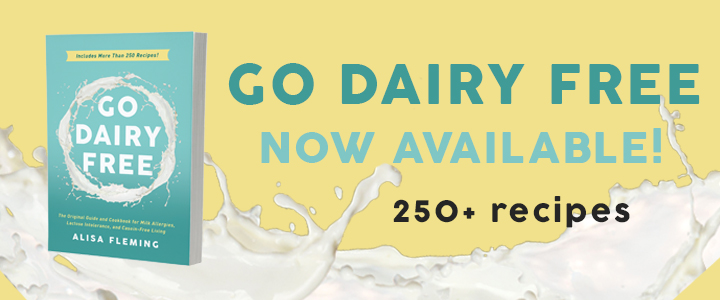I originally covered the topic of non dairy vs dairy free over a decade ago, when I received the following question from a Go Dairy Free reader named Donna.
I have a non-dairy creamer that has sodium caseinate (a milk derivative) and have noticed many other commercial brand non-dairy creamers with this ingredient. Does this make it still a dairy product? If so, how can it be called non dairy if it contains milk and isn’t dairy free?
The answer isn’t cut and dry, and has actually changed a little over the years. So I’m updating this post with the latest information, straight from the Food & Drug Administration (FDA).

Non Dairy vs Dairy Free: Why One May Contain Milk
By definition, “non” means “not”, so we would assume that a non-dairy product would not contain dairy. Unfortunately, this isn’t always the case due to some confusing labeling that the FDA permits.
How the Non-Dairy Conundrum Began
Many years ago, the FDA created a regulatory definition for the term non-dairy. It stated that a product labeled as non-dairy can contain 0.5% or less milk by weight, in the form of casein / caseinates (milk protein). The idea wasn’t to protect dairy-free consumers, but to prevent dairy consumers from mistaking very low-milk, dairy-like foods for dairy products.
What Non-Dairy Means Today
The FDA eventually retracted their official non-dairy definition, but they still have a general stance on what it means. A representative for the FDA provided the following “non-dairy response” to us in 2019.
We do not have a definition for the term [nondairy]in our regulations for food labeling. However, we do not consider the terms “nondairy” and “dairy free” to be equivalent. We have interpreted the term “dairy free” as meaning the complete absence of all dairy ingredients including lactose, etc. The term “nondairy” refers to products, such as nondairy whipped topping and nondairy creamers, that may contain a caseinate milk derivative.
What Dairy-Free Means
The FDA has never had a definition for the term dairy-free. As mentioned above, they have a general interpretation of the term, but they do not enforce or regulate it.
However, the FDA does state that labeling must be truthful and cannot be misleading. Consequently, consumers should be able to initially assume that a dairy-free product is made without dairy ingredients. You must then read the ingredient label to be sure. If you see the term dairy-free on a product that contains any type of milk in the ingredients, you are urged to notify the company and contact the FDA.
Remember that these labels address ingredients, not processes. If you are dealing with a severe milk allergy or other highly sensitive dairy concern, you must also contact the manufacturer to discuss their processes. The term dairy-free typically refers to the ingredients themselves, not the processes and potential allergen cross-contamination in manufacturing.
Non-Dairy Products are Often Dairy Free
Contrary to the FDA wording in their response above, most products labeled as “non-dairy” are in fact dairy-free by ingredients. Many companies choose to use the term non-dairy instead of dairy-free for a variety of reasons. Some say this label is more familiar and less intimidating to consumers. Others fear liability from using a “free from” term of any kind.
The “non-dairy” products that most often contain a small amount of casein (milk protein) are foods that we would think of as “dairy” products, like whipped toppings and creamers. Even then, most of the new “non-dairy” toppings, milk beverages, and creamers are made without any dairy ingredients. As time goes on, we’re seeing the terms non-dairy and dairy-free used more interchangeably.
Non-Dairy Foods and Allergen Labeling Laws
Although the term “non-dairy” may be misleading, food manufacturers cannot “hide” dairy in the ingredients. Our friends at the FDA shared this somewhat convoluted explanation of the requirements with us, but hopefully, you get the gist.
When foods characterized on the label as “nondairy” contain a caseinate ingredient, the caseinate ingredient must be followed by a parenthetical statement identifying its source. If the manufacturer uses the term “nondairy” on a creamer that contains sodium caseinate, it must include a parenthetical term such as “a milk derivative” after the listing of sodium caseinate in the ingredient list. (Reference: 21 CFR 101.4(d)).
In addition, milk and ingredients derived from milk such as casein (a milk protein) are major food allergens. Federal law requires the source of sodium caseinate to be indicated in the ingredient statement of a label, e.g., “sodium caseinate (milk).” Alternatively, the source of this ingredient may be indicated in a contains statement immediately after or adjacent to the ingredient statement, e.g., “Contains: milk.”
Tips for Finding Dairy-Free Non-Dairy Products
Look for Trusted Brands – Read ingredients, check websites, and call if necessary to find reliable dairy-free companies. Over time, you will probably find some beloved dairy-free companies that consistently provide you with the foods your craving. For those tricky non-dairy foods, I do have a Dairy-Free Coffee Creamer Guide and a Dairy-Free Whipped Topping Guide.
See the Dairy-Free Signs – To save time, scan packaging for labels that elude to a truly dairy-free product. As shown on the image of So Delicious Dairy Free CocoWhip Topping below, “dairy free” can be a good indicator, especially if it’s in the brand’s name! The Kosher Parve certification also denotes a product made without dairy. Finally, a product should not be labeled as “vegan” (though mistakes have happened) if it contains any dairy. When you spot what looks like a winner, double check the ingredients, and if needed, contact the company to inquire on their allergen processes.



57 Comments
Thanks for sharing! My 3 month old has a cow milk protein allergy. As his mama, I can’t eat or drink cow milk either so I can continue to breastfeed him. It has been a confusing journey! Glad there are posts like this where I can learn a bit more what to look for!
This helped me so much. My son suffers from CSID which leaves him unable to digest sucrose, maltose and lactose and I assumed that “dairy free”, sugar free and low starches was the way to go. I’ve learned a great deal about it now and we have discovered that he can have non-dairy as long as it doesn’t contain lactose and certain artifical sweetners if it isn’t sucrose or derived from sucrose (we try to stay away from the artificial sweetners anyway just in case. That’s a whole other confusing topic LOL. Took a bit of experimenting with his diet but now we seem to have it under control. Its obviously not an “allergy” but the effects are just as severe if we don’t manage it properly. Thank you from a frustrated mom!
So glad I can help and I hope your son sees improvement!
You mention casein and caseinates. My SIL has a reaction to whey powder, and needs to take Lactaid, or other latase enzyme product when she eats anything with whey powder. It is in a lot of cookies and baked goods. I am lactose intolerant, the 2 of us frequently have to ask “Could this obvious not dairy product, contain dairy?”
Hi Jane, there is a reason! The original FDA regulation that defined “non-dairy” allowed for caseinates specifically. And the further explanations that they have sent to me referenced casein, specifically. The references to casein are from the FDA directly. Their prior definition did not allow for whey to be in the product, and the FDA has never considered a product with whey in it to be nondairy. But since there isn’t an official definition anymore, and each label isn’t monitored, it could be possible for whey to be in a non-dairy product. But like any other dairy ingredient, whey should not be hidden in the product. It does need to be clear that there is milk in a product that contains whey, or the product should be reported.
As a heads up, lactase enzymes only help with the digestion of lactose. Whey is a protein, not a sugar, so enzymes will not help with allergies to whey. However, whey protein powder usually contains some amount of residual lactose. Lactase enzymes can help with digesting the lactose in whey, but won’t help with allergies to whey protein. You might already be aware of all this, but I was a little confused by your SIL having reactions to whey and taking lactase, and wanted to be sure other readers understand the topic.
thank you for updating this. I first developed ‘lactose intolerance’ and switched to powdered nondairy creamer at work and things eventually escalated with me spending my lunches choking and scaring my coworkers. I changed doctors and the new one sent me to an allergist who thought I had developed an almond/nut allergy (my fav nondairy creamer flavor ) but the blood test came back positive for dairy, and only dairy out of like 54 foods. It was the casein in the powdered creamer making me choke. So I Switched to powdered coconut milk and I haven’t choked since. The nondairy/ dairy free is a huge issue though since people try to go out of their way to accommodate me by supplying nondairy food which half the time has casein in it and and I can’t eat it. Then their feelings get hurt and I get accused of being overly sensitive and dramatic. The general public doesn’t get the difference.
I’m glad you found the answer Liz! But yes, a confusing topic for many people.
Thank you for this article and trying to clarify the difference between the 2 terms. I’m so angry that the FDA still allows the terminology ‘non-dairy’ for items that clearly do contain a form of dairy. I think it should be eliminated altogether. Either a product has dairy or it doesn’t. If it doesn’t, then it’s ‘dairy free’ – plain and simple. If it does contain any derivative of milk, it shouldn’t be labeled that it doesn’t. The inconsistency is confusing and not fair to those with allergens.
I couldn’t agree with you more Suzanne. It is very confusing and very dated. The food landscape has changed so much – I wish the labeling would keep up!
Hi Joan, since this is a dairy-free site, we don’t cover any type of dairy in detail, including a2 milk. Lactase drops do combat lactose intolerance symptoms (most of which you note) whether used with a1/a2 or a2 milk. From what I’ve read, the studies on a2 milk have been extremely limited, small, and funded primarily by the a2 company themselves. The company also notes that their product is not suitable for lactose intolerance, milk allergies, or other medical conditions and life choices. But I am happy to hear that you’ve found a solution that works for you!
Alisa, could you explain the difference between dairy free and lactose free, and the reason someone might decide to stay with dairy as long as it was lactose free?
And do you know of any resources for finding Lactose free dairy since Lactose free isn’t a category (unlike Gluten free) in grocery stores?
Hi Michael,
Do you have a copy of Go Dairy Free? In it, I discuss lactose intolerance in more detail and include general lactose percentages for different types of dairy foods, which can be helpful if you want to consume some dairy and have lactose intolerance. The book also discusses the differences between lactose free and dairy free, but that information is also in many posts on this site.
But I think what you are asking for is a dairy promotional post. We are not an anti-dairy website nor a pro-dairy website, and we are not affiliated with any organizations or companies. However, our core topic is dairy-free living. Which means the content helps people to live, enjoy, and understand dairy-free living if it is what they need, choose, or want more information about. For that reason (and because we have so much dairy-free content to cover!), we don’t cover topics about why people should consume dairy. Luckily, there are many dairy websites out there that do cover this topic! I suggest you search “dairy benefits” on google. No two people are the same. So a food that’s harmful for one person can be beneficial for another. It’s essential to discuss your diet with your doctor to decide what is best for you.
Unfortunately, there aren’t dairy-free sections in grocery stores either. We just read the labels and share what we find! You can usually find lactose-free products in the dairy section, and they are typically clearly labeled.
What are your opinions about a2 milk. I use it and treat it with lactase drops for 24 hours and I am not experiencing bloating, gas, indigestion, diarrhea or arthritis. I think it could be a big help for some of us.
My daughter’s class is doing a pram in which the regularly go to the local Senior Center. Her teacher sent me an e-mail asking for a list of foods that are safe so that he can send a copy of truly dairy free foods and snack items that he can have for in the classroom (there is another girl in thass with a severe dairy protein allergy) and he’s going to send a copy to the senior center as well.
Could you help with this, I know a number of things that my daughter can have, but our school board also bans peanuts and tree nut in all its schools too. This really narrows down what she can and cannot take to school, as she cannot have any animal dairy (due to cross allergens) due to a severe allergy, and she can’t take anything with anything peanut or anything tree nut due to school board policy
I’m one frustrated parent of a child with a severe dairy allergy.
Hi Donna, see my Printable Dairy-Free & Nut-Free snack list here -> https://www.godairyfree.org/news/nut-free-dairy-free-snack-list – it includes a list of brands / products.
Pingback: Natural Bliss Non-Dairy Creamers (Review): Almond and Coconut Milk
The beverage ‘No Milk’ lists water then 3 milk proteins in the first 4 ingredients, and they label their beverage ‘NON DAIRY’. Does this mean this beverage is less than 5% dairy?
This sounds very strange. You can’t legally label something as non-dairy unless it contains .5% (that’s a half of a percent) or less of dairy. If milk proteins are 3 of the 4 first ingredients, then I don’t see how it could be called non-dairy or “no milk” since it is milk. I couldn’t answer you clearly without seeing the product.
Thank you for your website and all the work involved to keep it current. I’m still confused about ghee and if my son can have it. We are working on getting him on the autism diet which is dairy-free, casesin-free, soy-free and gluten-free. I’m trying to alter recipes and I thought ghee would work for butter in recipes as an alternative but the diet list says no ghee and I’m wondering why and if it would be a safe alternative. I would welcome any help because I see a lot of people comment on other sites that they are dairy-free but they eat ghee. Thank you!
Hi Alex, this post should help you – http://www.godairyfree.org/ask-alisa/ask-alisa-i-am-sensitive-to-milk-protein-but-can-i-tolerate-dairy-foods-that-are-mostly-fat
I also recommend getting a copy of my book, Go Dairy Free, it answers almost all of the dairy-free questions you will likely have.
Pingback: Vegan Iced Coffee with a Kick Recipe - Go Dairy Free